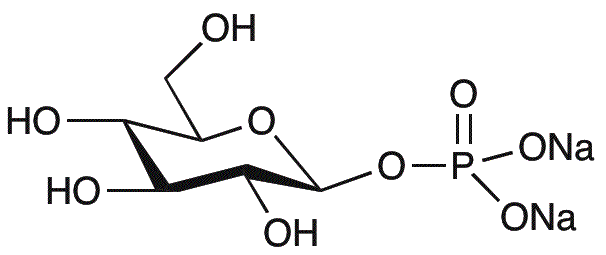b-D-Glucopyranose 1-phosphate disodium salt is widely utilized in research focused on:
- Biochemical Research: It serves as a critical substrate in enzymatic assays, helping researchers study carbohydrate metabolism and enzyme kinetics.
- Pharmaceutical Development: This compound is used in drug formulation processes, particularly in the development of therapies targeting metabolic disorders, enhancing drug efficacy and stability.
- Food Industry: It acts as a food additive, providing sweetness and enhancing the nutritional profile of products, making it valuable for health-conscious formulations.
- Diagnostics: Employed in diagnostic assays to measure glucose levels, it aids in the monitoring of diabetes and other metabolic conditions, offering precise and reliable results.
- Biotechnology: It plays a role in the production of recombinant proteins, facilitating the growth of microorganisms in fermentation processes, thus improving yield and efficiency.
General Information
Properties
Safety and Regulations
Applications
b-D-Glucopyranose 1-phosphate disodium salt is widely utilized in research focused on:
- Biochemical Research: It serves as a critical substrate in enzymatic assays, helping researchers study carbohydrate metabolism and enzyme kinetics.
- Pharmaceutical Development: This compound is used in drug formulation processes, particularly in the development of therapies targeting metabolic disorders, enhancing drug efficacy and stability.
- Food Industry: It acts as a food additive, providing sweetness and enhancing the nutritional profile of products, making it valuable for health-conscious formulations.
- Diagnostics: Employed in diagnostic assays to measure glucose levels, it aids in the monitoring of diabetes and other metabolic conditions, offering precise and reliable results.
- Biotechnology: It plays a role in the production of recombinant proteins, facilitating the growth of microorganisms in fermentation processes, thus improving yield and efficiency.
Documents
Safety Data Sheets (SDS)
The SDS provides comprehensive safety information on handling, storage, and disposal of the product.
Product Specification (PS)
The PS provides a comprehensive breakdown of the product’s properties, including chemical composition, physical state, purity, and storage requirements. It also details acceptable quality ranges and the product's intended applications.
Certificates of Analysis (COA)
Search for Certificates of Analysis (COA) by entering the products Lot Number. Lot and Batch Numbers can be found on a product’s label following the words ‘Lot’ or ‘Batch’.
*Catalog Number
*Lot Number
Certificates Of Origin (COO)
This COO confirms the country where the product was manufactured, and also details the materials and components used in it and whether it is derived from natural, synthetic, or other specific sources. This certificate may be required for customs, trade, and regulatory compliance.
*Catalog Number
*Lot Number
Safety Data Sheets (SDS)
The SDS provides comprehensive safety information on handling, storage, and disposal of the product.
DownloadProduct Specification (PS)
The PS provides a comprehensive breakdown of the product’s properties, including chemical composition, physical state, purity, and storage requirements. It also details acceptable quality ranges and the product's intended applications.
DownloadCertificates of Analysis (COA)
Search for Certificates of Analysis (COA) by entering the products Lot Number. Lot and Batch Numbers can be found on a product’s label following the words ‘Lot’ or ‘Batch’.
*Catalog Number
*Lot Number
Certificates Of Origin (COO)
This COO confirms the country where the product was manufactured, and also details the materials and components used in it and whether it is derived from natural, synthetic, or other specific sources. This certificate may be required for customs, trade, and regulatory compliance.

